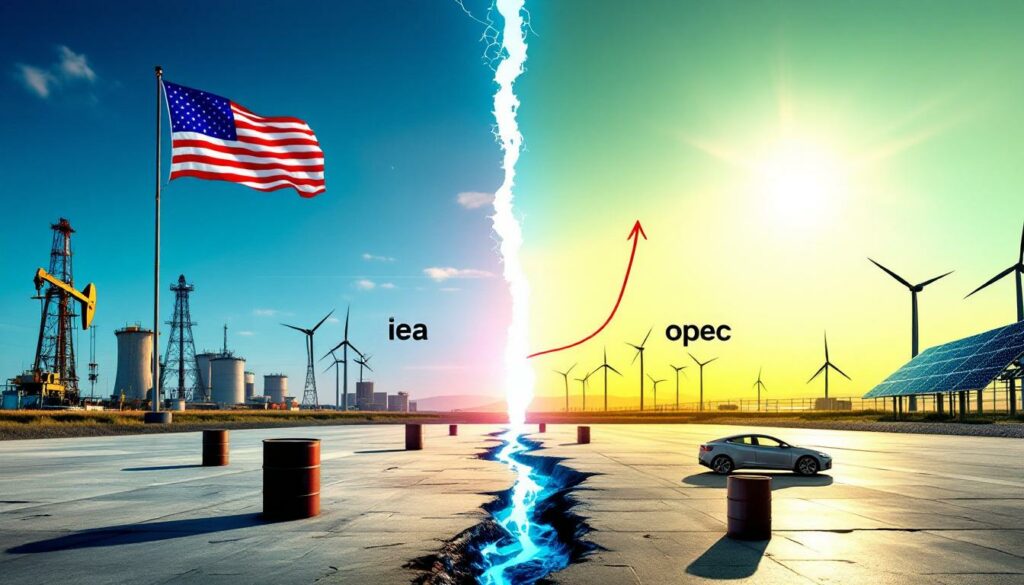Why Is the U.S. Threatening to Leave the IEA?
The United States is considering a dramatic withdrawal from the International Energy Agency (IEA), citing fundamental disagreements about the organization's current mission and forecasting approach. This potential diplomatic rupture centers on the IEA's increasingly vocal advocacy for green energy transition, which U.S. Energy Secretary Chris Wright has characterized as a departure from the agency's core mandate.
"We will reform the way the IEA operates or we will withdraw," Wright stated bluntly in a recent Bloomberg interview, sending shockwaves through international energy governance circles. This unusually direct threat from the United States—the IEA's largest financial contributor—highlights growing tensions between traditional energy interests and climate policy priorities.
The dispute fundamentally revolves around divergent visions of the global energy future. While the IEA projects oil demand growth slowing significantly before peaking this decade, U.S. officials and OPEC oil market influence countries contend this forecast underestimates future fossil fuel demand and risks undermining energy security.
"The IEA was established to ensure energy security, not to advocate for particular energy technologies or policies. Their recent forecasts have strayed far from objective analysis." — U.S. Energy Secretary Chris Wright
This potential withdrawal would represent the most significant shift in international energy cooperation since the IEA's founding over five decades ago, with wide-ranging implications for global energy markets, climate policy, and geopolitical alignments.
What Is the IEA and Why Does It Matter?
Origins and Original Purpose
The International Energy Agency emerged from a specific geopolitical crisis. Following the 1973 oil embargo imposed by Arab oil-producing nations, Western industrialized countries found themselves vulnerable to supply disruptions and price shocks. In response, 16 OECD nations established the IEA in November 1974 as a counterbalance to OPEC's market power.
The organization's founding treaty outlined several core functions:
- Maintaining emergency oil reserves equivalent to at least 90 days of net imports
- Developing coordinated response mechanisms for supply disruptions
- Collecting and analyzing comprehensive energy data
- Promoting energy security through international cooperation
- Providing member countries with reliable market intelligence
This mandate reflected the energy landscape of the 1970s—heavily focused on oil security at a time when fossil fuels dominated global energy systems without significant competition.
Evolution of the IEA's Mission
Over five decades, the IEA has undergone a remarkable transformation, expanding both its membership and mission. Today's IEA includes 31 member countries plus association agreements with major economies like China and India—a far cry from its original Western-focused membership.
More significantly, the organization's substantive focus has broadened dramatically:
- 1970s-1990s: Primarily focused on oil security and market monitoring
- Early 2000s: Expanded analysis to include natural gas markets and energy efficiency
- 2010s: Increased emphasis on renewable energy technologies and climate considerations
- Post-Paris Agreement: Developed comprehensive energy transition roadmaps, including the influential "Net Zero by 2050" pathway
This evolution reflects broader changes in global energy priorities, as energy transition security concerns have risen on the international agenda alongside traditional energy security considerations.
The IEA's annual publications—particularly its flagship World Energy Outlook—have become essential reference points for governments, corporations, and investors. The organization's forecasts and scenarios significantly influence capital allocation decisions worth trillions of dollars across the global energy sector.
"The IEA has transformed from an oil security mechanism into the world's most authoritative voice on energy transitions." — Former IEA Executive Director
However, this evolution has not been without controversy. Traditional energy producers increasingly question whether the IEA has strayed too far from its original mandate, while climate advocates argue it hasn't gone far enough in promoting decarbonization.
What Are the Current Tensions Between the U.S. and IEA?
The U.S. Position
The United States' grievances with the IEA center on what Energy Secretary Wright describes as the organization's shift "from being an objective forecaster to being an advocate" for green energy technologies. According to Wright, this advocacy role contradicts the IEA's founding purpose and compromises its analytical integrity.
The administration has outlined two clear options:
- Reform the IEA to refocus on objective data analysis and energy security
- Withdraw U.S. membership and funding entirely (representing approximately 25% of the IEA's operating budget)
"My strong preference is to reform it," Wright clarified, though he emphasized the seriousness of the withdrawal threat if changes aren't implemented.
Specific U.S. criticisms include:
- Forecasting methodology: Wright called the IEA's projections of peak oil demand "total nonsense" and methodologically flawed
- Policy bias: Claims that IEA analysis increasingly assumes rather than evaluates aggressive climate policies
- Mission drift: Assertion that the organization has abandoned its core energy security mandate
- Investor influence: Concerns that IEA forecasts discourage necessary investment in traditional energy infrastructure
This position represents a significant shift in U.S. engagement with the IEA, which the country helped establish and has consistently supported for five decades.
The IEA's Current Stance
Under Executive Director Fatih Birol's leadership since 2015, the IEA has increasingly positioned itself as a leading voice on energy transition. The organization's flagship publications now prominently feature:
- Detailed pathways to achieve net-zero emissions by 2050
- Forecasts showing global oil demand peaking before 2030
- Analysis highlighting the rapid growth potential of electric vehicles and renewable energy
- Warnings that new fossil fuel development is inconsistent with climate goals
In its most recent Medium-Term Oil Market Report, the IEA projected annual demand growth slowing to approximately 700,000 barrels per day in 2025-2026, with further deceleration leading to a plateau and eventual decline by 2030. This forecast reflects what the IEA calls "structural changes" in oil consumption patterns, particularly in the transportation sector.
Birol has defended the organization's approach as consistent with rigorous analysis of emerging trends and existing policy commitments. The IEA maintains that its forecasts reflect objective assessment of market developments rather than advocacy positions.
"Our scenarios are based on stated policies and technological trends, not wishful thinking," Birol stated in response to criticism, though he has not directly addressed Wright's withdrawal threat.
How Do the IEA and OPEC Forecasts Differ?
The stark divergence between IEA and OPEC oil demand projections illustrates fundamentally different visions of the energy future and highlights why the current tensions matter for global markets.
IEA Projections
The IEA's medium-term forecast presents a picture of oil demand gradually losing momentum:
| Year | IEA Projected Oil Demand Growth |
|---|---|
| 2024 | ~1.2 million bpd annual growth |
| 2025-2026 | ~700,000 bpd annual growth |
| 2027-2029 | Further deceleration to <500,000 bpd |
| 2030 | Small decline expected |
This projection stems from several key assumptions:
- Electric vehicle adoption accelerating globally (30% of new car sales by 2030)
- Continued efficiency improvements in conventional vehicles
- Structural economic shifts toward less energy-intensive services
- Renewable energy displacing oil in power generation and heating
- Modest but consistent policy pressure toward decarbonization
The IEA's methodology incorporates current policy settings rather than aspirational climate targets, but still concludes that technological and economic factors are driving a fundamental shift in oil consumption patterns.
OPEC Projections
OPEC's outlook presents a dramatically different future trajectory:
| Year | OPEC Projected Global Oil Demand |
|---|---|
| 2025 | ~105 million bpd |
| 2030 | ~110 million bpd |
| 2040 | ~117 million bpd |
| 2050 | 123 million bpd |
This forecast assumes:
- Continued population growth driving energy demand
- Industrialization in developing economies requiring more oil
- Limited penetration of alternative technologies, especially in non-OECD countries
- Economic growth remaining tightly coupled with oil consumption
- Relatively modest policy constraints on fossil fuel use
OPEC Secretary General Haitham Al Ghais has criticized the IEA's projections as "dangerous," arguing they could lead to "energy volatility on an unprecedented scale" by discouraging necessary investments in production capacity.
Methodological Differences
These divergent forecasts stem from fundamentally different analytical approaches:
- IEA: Uses scenario-based modeling that incorporates technology adoption curves, efficiency improvements, and current policy commitments
- OPEC: Employs economic growth models that emphasize historical relationships between GDP and oil consumption
The gap between these projections—nearly 20 million barrels per day by 2050—represents trillions of dollars in potential investment decisions and has profound implications for energy security planning.
"This isn't just a technical disagreement—it's a battle over the narrative that will shape the future of global energy systems." — Energy market analyst
What Would U.S. Withdrawal Mean for Global Energy Governance?
Potential Consequences
If the United States were to follow through on its threat to leave the IEA, the implications would be far-reaching:
For the IEA itself:
- Significant budget shortfall (U.S. contributes approximately 25% of funding)
- Diminished geopolitical influence without world's largest economy
- Potential exodus of other member countries with similar concerns
- Challenges to data collection capabilities and emergency response mechanisms
For global energy governance:
- Fragmentation of international cooperation frameworks
- Greater influence for OPEC in shaping energy narratives and market expectations
- Potential emergence of competing institutions or forums
- Weakened coordinated response capacity during supply disruptions
For energy markets:
- Increased uncertainty about demand forecasts and their reliability
- Potential volatility as investors navigate conflicting signals
- Questions about the future of strategic petroleum reserves coordination
- Possible acceleration of divergent energy paths between regions
The U.S. withdrawal would represent the first major member departure in the IEA's history, creating an unprecedented challenge to the organization's legitimacy and effectiveness.
Historical Context
To understand the significance of this potential break, it's worth considering several historical milestones:
- 1974: IEA founded with 16 members as direct response to OPEC embargo
- 1991: IEA coordinated release of emergency oil stocks during Gulf War (first major test)
- 2005: China and India invited as "observers" despite not being OECD members
- 2015: Association agreements expanded IEA influence to major emerging economies
- 2022: Coordinated release of 60 million barrels during Russia-Ukraine conflict
Throughout these developments, the United States remained the IEA's largest financial contributor and a key diplomatic supporter. A U.S. withdrawal would mark a fundamental rupture in this long-standing relationship, occurring at a time when international energy cooperation faces multiple challenges from trade war oil impact and technological disruption.
Some analysts speculate that U.S. withdrawal could prompt the creation of alternative energy forums—possibly aligned with specific regional or ideological blocs—further complicating global energy governance at a critical juncture.
How Does This Reflect Broader Energy Policy Debates?
Competing Visions
The confrontation between the U.S. and IEA represents more than an institutional dispute—it reflects fundamentally competing visions about energy's future:
Vision 1: Managed Energy Transition
- Climate imperatives require deliberate policy intervention
- Peak oil demand is imminent due to technological and policy forces
- Renewable energy will displace fossil fuels in most applications
- Investment should shift rapidly toward low-carbon alternatives
Vision 2: Market-Driven Evolution
- Energy security requires continued fossil fuel investment
- Oil and gas demand will grow for decades in developing economies
- Technology transitions should occur at economically optimal pace
- Policy should remain neutral between energy sources
These divergent perspectives manifest in concrete policy disagreements:
- Investment signals: Should forecasts emphasize climate risks or undersupply risks?
- Timeframes: Is energy transition a matter of decades or generations?
- Government role: Should policy actively accelerate or merely accommodate transitions?
- International equity: How should transition costs be distributed between nations?
Political Dimensions
The U.S. position aligns with broader shifts in American energy policy, including:
- Prioritization of domestic energy abundance and security
- Skepticism toward international climate frameworks that could constrain U.S. options
- Support for traditional energy industries and their economic contributions
- Preference for market-driven rather than policy-driven technology adoption
This stance reflects both economic interests and ideological perspectives about the proper role of government in energy markets. The United States, having achieved energy self-sufficiency through its shale revolution, has different strategic priorities than many IEA member countries that remain import-dependent.
Meanwhile, the IEA's evolution mirrors the European-led emphasis on climate action as a central energy policy priority—a perspective that has gained traction among many member states but clearly not universal acceptance.
"What we're witnessing is not just an institutional spat, but a fundamental collision between competing models of energy governance." — International energy policy expert
What Are the Implications for Energy Markets?
Market Signals
The U.S. threat to withdraw from the IEA sends several powerful signals to global energy markets:
- Investment uncertainty: Conflicting demand forecasts complicate capital allocation decisions
- Credibility questions: Challenges to IEA methodology may undermine its market influence
- Policy divergence: Suggests accelerating gaps between regional energy approaches
- Volatility potential: Disagreements about future supply adequacy could drive price swings
With WTI crude trading at $65.87 per barrel (as of July 16, 2025), markets have remained relatively stable despite the diplomatic tensions. However, analysts note that longer-term investment decisions increasingly face a "forecasting dilemma" as authoritative sources diverge.
Investment Considerations
Energy companies and investors must navigate particularly challenging terrain:
For traditional oil and gas companies:
- Determining appropriate exploration and production investments
- Balancing shareholder demands for returns against transition pressures
- Evaluating portfolio diversification options and timelines
- Managing potential stranded asset risks under various scenarios
For renewable energy developers:
- Assessing growth trajectories with uncertain policy support
- Preparing for potential volatility in fossil fuel prices
- Navigating changing subsidy and regulatory landscapes
- Determining optimal scaling strategies amid conflicting signals
For financial institutions:
- Evaluating energy transition risks in lending portfolios
- Developing appropriate climate risk disclosure frameworks
- Balancing shareholder activism with energy security considerations
- Determining sectoral allocation strategies amid divergent forecasts
Morgan Stanley recently revised its long-term oil price outlook downward, citing IEA forecasts as a key factor—illustrating how influential these projections remain despite the current controversy. Furthermore, the current oil price rally factors demonstrate the complex interplay between geopolitics and market fundamentals.
"The financial consequences of getting this wrong are measured in trillions, not billions." — Investment analyst at major energy fund
What Are the Next Steps?
Potential Reforms
Secretary Wright indicated a preference for reforming the IEA rather than withdrawing. While specific proposals remain undefined, several reform approaches have been suggested:
- Methodological transparency: Greater disclosure of assumptions underlying demand forecasts
- Scenario diversity: Expanding the range of future scenarios to include higher demand possibilities
- Governance balance: Ensuring leadership represents diverse energy perspectives
- Mission refocus: Reemphasizing energy security alongside transition considerations
- Analytical firewall: Separating objective analysis from policy advocacy functions
These reforms would aim to address U.S. concerns while preserving the IEA's role as an authoritative source of energy data and analysis. However, implementing such changes would require consensus among member countries with divergent priorities.
Timeline and Process
The path forward remains uncertain, but several key developments bear watching:
- Diplomatic engagement: Ongoing discussions between U.S. officials and IEA leadership
- IEA Ministerial Meeting: Scheduled for February 2026, this could be a decision point
- Interim adjustments: Potential methodological modifications to upcoming IEA reports
- Alternative frameworks: Possible development of supplementary international energy forums
- Member reactions: Responses from other key IEA contributors like Japan, Germany, and the UK
Energy analysts suggest that the most likely outcome is a negotiated compromise, given the significant costs of a complete rupture for both the United States and the IEA. However, the fundamental tensions between energy security and climate priorities will continue to challenge international energy governance regardless of the institutional outcome. The broader tariff economic implications could also influence how energy policies evolve globally.
"Both sides have strong incentives to find a middle ground, but the underlying tensions won't disappear with procedural adjustments." — International relations expert
FAQ: U.S. and IE
Want to Stay Ahead of Market-Moving Mineral Discoveries?
Discover significant mineral finds before the broader market with Discovery Alert's proprietary Discovery IQ model, delivering real-time notifications on high-potential ASX announcements. Visit our discoveries page to see how early investors have capitalised on historic mineral discoveries.




